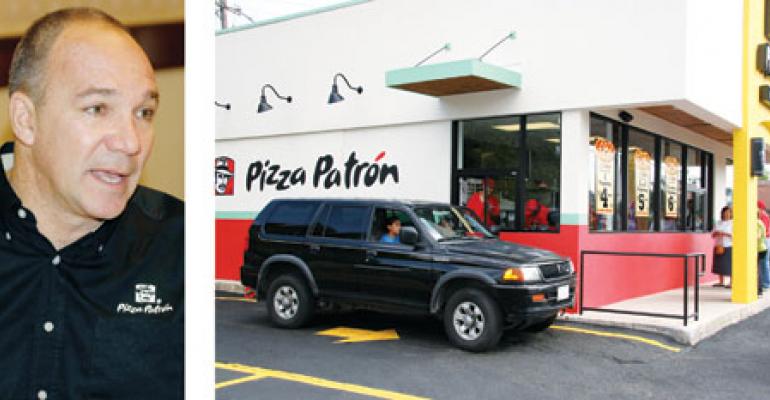SAN ANTONIO Pizza Patrón’s 2007 franchisee conference, founder and CEO Antonio Swad unveiled a drawing of the company’s store of the future: a free-standing, pad-built 1,200 square-foot unit with a veritable three-way freeway of distribution points: an exterior order window, an inside order counter and a drive-thru window, the chain’s first. —At
That au courant design was history just a few months later, however, when a newer, less-expensive and sleeker 900-square foot design emerged. When that drawing became reality last August in San Antonio, customers literally swarmed the place. —At
But while revenues smashed the 84-unit chain’s previous store-opening sales record by 67 percent, Patrón’s downsized dandy presented a problem. —At
“We found out quickly that it was a challenge to do that much volume in such a small space,” said Andy Gamm, director of business development for Dallas-based Pizza Patrón. —At
When the store ran out of storage space, the franchisee had to build temporary shelter. Gamm added wryly, “We’re making some accommodations for that in future designs.” —At
Swad called the new design a win-win for the company and its franchisees. Built at a cost of about $350,000 he said the new format yields “about a 3-1 sales-to-investment ratio. That’s a home run for us and for our [franchisee] partners—especially when you’re selling food items with pretty reasonable margins like we are.” —At
A typical Pizza Patrón buildout cost is about $200,000. —At
It doesn’t hurt that those margins are rapidly improving lately with flour and cheese prices down substantially from record highs in 2008. Those factors, plus the excitement over the new unit design have Pizza Patrón leaders and franchisees planning to expand this year. —At
Internally, the new design is known as “QSP,” short for quick-service pizza, and its built-for-speed design dovetails nicely into Pizza Patrón’s proven Lista, which translates as “now ready,” service. The carryout-centered system works by prebaking and holding pizzas for rapid transactions during peak periods. —At
Last year, Lista got an added speed boost when some stores upgraded to new “fast bake” air impingement ovens that cook Patrón’s pies in under four minutes—roughly three minutes faster than the cook time in regular ovens. —At
The staff at the QSP unit prepares for peak times by pre-saucing and precheesing multiple pizzas and pre-baking Lista pizzas. When customers come to the drive-thru, they can order from the Lista menu, which includes three standard pies, or choose their own toppings. A non-Lista pizza takes five minutes to make, bake and box. —At
The challenge, Swad said, is to serve all customers equally fast, regardless of their choice. —At
“If the car in front of another in the queue wants a pizza with no mushrooms and half jalapenos, the trick is to do it like they do in QSR: with no difference perceived by the customer,” he said. —At
“We also believe five minutes isn’t an unreasonable amount of time to make customers wait for a fresh, burn-your-lap-hot pizza, he added.” —At
Gamm said the arrival of QSP meets a profound shift in pizza customers’ buying habits: They’re less focused on customized orders and more interested in getting it quickly. —At
“We saw the need to make pizza buying more convenient for our customers…to find ways for them to get it right now,” Gamm said. “That people are ready for this concept now is partly due to the proliferation of other QSR concepts. We don’t have to educate them on this. They don’t have to get out of their cars; the process is easy for them.” —At
Gamm said learning to juggle three points of distribution was a struggle initially for the staff, since no prior Pizza Patrón had a true drive-thru. —At
“The exterior menu and speaker system was totally foreign to our system,” he said “But fortunately our partner has a lot of QSR experience with that.” —At
Beyond the early adjustments, the operation actually is simpler to run, Swad said. —At
“Because of the pace of sales, it does take more employees to run this operation than in a normal unit, but you get more efficient use of that labor than in our standard inline stores,” he said. —At
“The way the unit is designed, you can serve at least two of the three distribution points using the same person, rather than having one person for each,” he added. “Needing more people is a good problem to have if you can justify it by being busy.” —At




